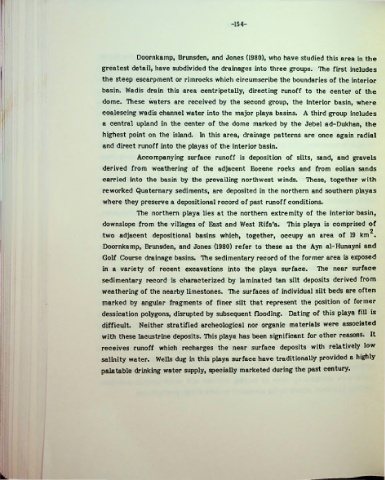Page 178 - Life & Land Use on the Bahrain Islands (Curtis E Larsen)
P. 178
-154-
Doornkamp, Brunsden, and Jones (1980), who have studied this area in the
greatest detail, have subdivided the drainages into three groups. The first includes
the steep escarpment or rimrocks which circumscribe the boundaries of the interior
basin. Wadis drain this area centripetally, directing runoff to the center of the
dome. These waters are received by the second group, the interior basin, where
coalescing wadis channel water into the major playa basins. A third group includes
a central upland in the center of the dome marked by the Jebel ad-Dukhan, the
highest point on the island. In this area, drainage patterns are once again radial
and direct runoff into the playas of the interior basin.
Accompanying surface runoff is deposition of silts, sand, and gravels
derived from weathering of the adjacent Eocene rocks and from eolian sands
carried into the basin by the prevailing northwest winds. These, together with
reworked Quaternary sediments, are deposited in the northern and southern playas
where they preserve a depositional record of past runoff conditions.
The northern playa lies at the northern extremity of the interior basin,
downslope from the villages of East and West RifaTa. This playa is comprised of
2
two adjacent depositional basins which, together, occupy an area of 19 km .
Doornkamp, Brunsden, and Jones (1980) refer to these as the Ayn al-Hunayni and
Golf Course drainage basins. The sedimentary record of the former area is exposed
in a variety of recent excavations into the playa surface. The near surface
sedimentary record is characterized by laminated tan silt deposits derived from
weathering of the nearby limestones. The surfaces of individual silt beds are often
marked by angular fragments of finer silt that represent the position of former
dessication polygons, disrupted by subsequent flooding. Dating of this playa fill is
difficult. Neither stratified archeological nor organic materials were associated
with these lacustrine deposits. This playa has been significant for other reasons. It
receives runoff which recharges the near surface deposits with relatively low
salinity water. Wells dug in this playa surface have traditionally provided a highly
palatable drinking water supply, specially marketed during the past century.

